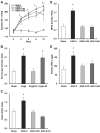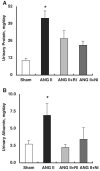Crucial role of Rho-nuclear factor-kappaB axis in angiotensin II-induced renal injury
- PMID: 17409276
- PMCID: PMC2094126
- DOI: 10.1152/ajprenal.00520.2006
Crucial role of Rho-nuclear factor-kappaB axis in angiotensin II-induced renal injury
Abstract
This study was performed to determine the effectiveness of the Rho kinase inhibitor and NF-kappaB inhibitor in renal injury of ANG II-infused hypertensive rats. Male Sprague-Dawley rats, maintained on a normal diet, received either a sham operation (n = 7) or continuous ANG II infusion (120 ng/min) subcutaneously via minipumps. The ANG II-infused rats were further subdivided into three subgroups (n = 7 each) to receive one of the following treatments during the entire period: vehicle, Rho kinase inhibitor (fasudil; 3 mg.kg(-1).day(-1) ip), or NF-kappaB inhibitor (parthenolide; 1 mg.kg(-1).day(-1) ip). After 12 days of ANG II infusion, systolic blood pressure (BP; 208 +/- 7 vs. 136 +/- 3 mmHg), Rho kinase activity, NF-kappaB activity, renal ANG II contents (160 +/- 25 vs. 84 +/- 14 pg/g), monocytic chemotactic protein (MCP) 1 mRNA, interstitial macrophage infiltration, transforming growth factor-beta1 (TGF-beta1) mRNA, interstitial collagen-positive area, urinary protein excretion (43 +/- 6 vs. 11 +/- 2 mg/day), and urinary albumin excretion were significantly enhanced compared with the Sham group. While fasudil or parthenolide did not alter systolic BP (222 +/- and 190 +/- 21, respectively), both treatments completely blocked ANG II-induced enhancement of NF-kappaB activity, renal ANG II contents (103 +/- 11 and 116 +/- 21 pg/g, respectively), MCP1 mRNA, interstitial macrophage infiltration, TGF-beta1 mRNA, interstitial collagen-positive area, urinary protein excretion (28 +/- 6 and 23 +/- 3 mg/day, respectively), and urinary albumin excretion. Importantly, parthenolide did not alter ANG II-induced Rho kinase activation although fasudil abolished ANG II-induced Rho kinase activation. These data indicate that the Rho-NF-kappaB axis plays crucial roles in the development of ANG II-induced renal injury independently from BP regulation.
Figures





Similar articles
-
Sustained renal interstitial macrophage infiltration following chronic angiotensin II infusions.Am J Physiol Renal Physiol. 2007 Jan;292(1):F330-9. doi: 10.1152/ajprenal.00059.2006. Epub 2006 Jun 27. Am J Physiol Renal Physiol. 2007. PMID: 16804106 Free PMC article.
-
Angiotensin II increases intrarenal transforming growth factor-beta1 in rats submitted to sodium overload independently of blood pressure.Hypertens Res. 2008 Apr;31(4):707-15. doi: 10.1291/hypres.31.707. Hypertens Res. 2008. PMID: 18633183
-
The Rho-kinase pathway regulates angiotensin II-induced renal damage.Kidney Int Suppl. 2005 Dec;(99):S39-45. doi: 10.1111/j.1523-1755.2005.09908.x. Kidney Int Suppl. 2005. PMID: 16336575
-
Mycophenolate mofetil prevents salt-sensitive hypertension resulting from angiotensin II exposure.Kidney Int. 2001 Jun;59(6):2222-32. doi: 10.1046/j.1523-1755.2001.00737.x. Kidney Int. 2001. PMID: 11380825
-
Can we predict the effects of NF-kappaB inhibition in sepsis? Studies with parthenolide and ethyl pyruvate.Expert Opin Investig Drugs. 2009 Aug;18(8):1047-60. doi: 10.1517/13543780903018880. Expert Opin Investig Drugs. 2009. PMID: 19555300 Free PMC article. Review.
Cited by
-
Nuclear factor-kappaB as a hormonal intracellular signaling molecule: focus on angiotensin II-induced cardiovascular and renal injury.Curr Opin Nephrol Hypertens. 2008 Jan;17(1):37-43. doi: 10.1097/MNH.0b013e3282f2903c. Curr Opin Nephrol Hypertens. 2008. PMID: 18090668 Free PMC article. Review.
-
The role of Rho protein signaling in hypertension.Nat Rev Cardiol. 2010 Nov;7(11):637-47. doi: 10.1038/nrcardio.2010.136. Epub 2010 Aug 31. Nat Rev Cardiol. 2010. PMID: 20808285 Review.
-
Sequential activation of the reactive oxygen species/angiotensinogen/renin-angiotensin system axis in renal injury of type 2 diabetic rats.Clin Exp Pharmacol Physiol. 2008 Aug;35(8):922-7. doi: 10.1111/j.1440-1681.2008.04938.x. Epub 2008 Apr 21. Clin Exp Pharmacol Physiol. 2008. PMID: 18430060 Free PMC article.
-
Simvastatin inhibits angiotensin II-induced abdominal aortic aneurysm formation in apolipoprotein E-knockout mice: possible role of ERK.Arterioscler Thromb Vasc Biol. 2009 Nov;29(11):1764-71. doi: 10.1161/ATVBAHA.109.192609. Epub 2009 Sep 3. Arterioscler Thromb Vasc Biol. 2009. PMID: 19729613 Free PMC article.
-
The Urinary Angiotensinogen to Urinary Albumin Ratio Reflects Whether the Renin-angiotensin System in the Kidney Is Activated due to Filtration of Plasma Angiotensinogen through the Damaged Glomeruli or the Production of Angiotensinogen in the Proximal Tubules.Intern Med. 2020 Feb 1;59(3):357-364. doi: 10.2169/internalmedicine.3624-19. Epub 2019 Sep 18. Intern Med. 2020. PMID: 31534091 Free PMC article.
References
-
- Amano M, Chihara K, Kimura K, Fukata Y, Nakamura N, Matsuura Y, Kaibuchi K. Formation of actin stress fibers and focal adhesions enhanced by Rho-kinase. Science. 1997;275:1308–1311. - PubMed
-
- Asano T, Ikegaki I, Satoh S, Suzuki Y, Shibuya M, Takayasu M, Hidaka H. Mechanism of action of a novel antivasospasm drug, HA1077. J Pharmacol Exp Ther. 1987;241:1033–1040. - PubMed
-
- Beutler KT, Masilamani S, Turban S, Nielsen J, Brooks HL, Ageloff S, Fenton RA, Packer RK, Knepper MA. Long-term regulation of ENaC expression in kidney by angiotensin II. Hypertension. 2003;41:1143–1150. - PubMed
Publication types
MeSH terms
Substances
Grants and funding
LinkOut - more resources
Full Text Sources
Miscellaneous

